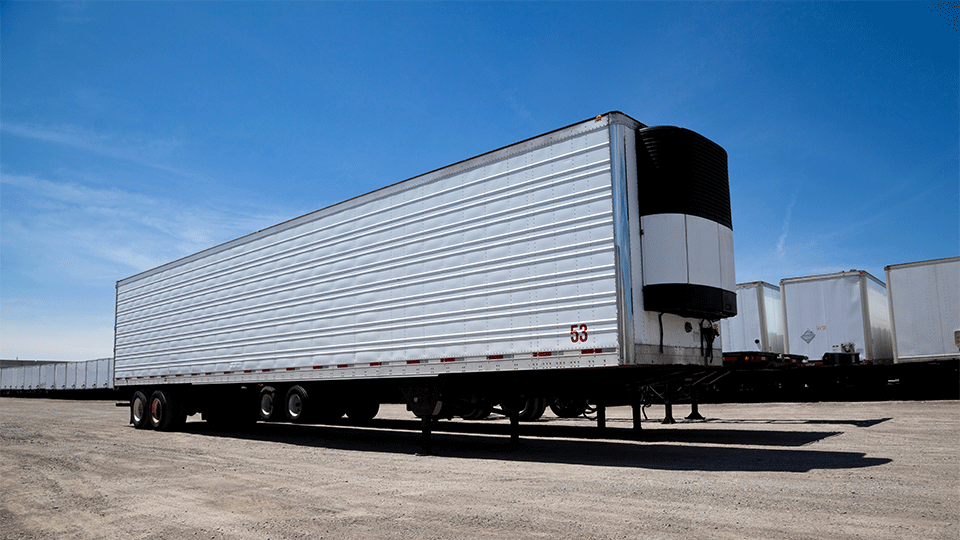 Depending on the time of year, your freight rates will change. Seasonality shifts load-to-truck ratios in many regions as the year progresses. As a result, your transportation spending will rise and fall with the seasons.
Depending on the time of year, your freight rates will change. Seasonality shifts load-to-truck ratios in many regions as the year progresses. As a result, your transportation spending will rise and fall with the seasons.
But you already know that.
As a logistics professional, your days are spent overseeing the facilitation of your company’s supply chain — a job you do well.
However, moving temperature-controlled cargo is complex. Your freight, which is sensitive to changes in temperature, also needs to be reliably picked up and delivered on time. On-time performance from your transportation providers is non-negotiable in your industry — as it should be.
That said, as the year progresses, and the supply of, and demand for, reefer capacity shifts across the U.S., securing a competitively-priced solution — one priced to execute your load — takes an understanding of these changes.
At ATS Logistics, our temperature-controlled services are priced based on market research and decades of experience. Over the years, we’ve seen how impactful seasonal shifts in the reefer space are on underprepared shippers.
It’s never convenient to pay more than you expected to move a load. With the information below (and a good network for carriers, of course), you can avoid future surprises.
In this article, we’ll tell you how location and time of year drive reefer pricing. That way, you’re prepared to successfully execute your load, regardless of the time of year.
Below, you’ll learn about:
- The three largest influencers of refrigerated shipping spot prices
- The most prominent refrigerated shipping peak seasons and locations
- The main refrigerated shipping down seasons and locations
The 3 Largest Influencers of Refrigerated Shipping Spot Prices
The refrigerated transportation marketplace, like the open–deck and dry van markets, is influenced by a wide range of external factors. That said, time after time, the three largest influencers of reefer spot rates are:
- The temperature your freight needs to move at
- Your origin and destination locations
- The time of year you’re shipping freight
Together, these specifics drive the final rate you pay to move reefer cargo. Let’s take a closer look at why your freight’s temperature, the location you’re shipping from and the time of year are such large price drivers. . .
1 | The Temperature Your Freight Needs to Move at
Refrigerated trailers have two main cooling settings, selected based on the needs of the cargo within them. These settings are “start-stop” and “continuous” cooling.
As a brief rundown, start-stop cooling is used when a reefer’s temperature needs to avoid falling out of a certain range. For example, if cargo is sensitive to temperatures above 50 degrees, start-stop would engage the cooling unit every time the reefer’s internal temperature approaches this mark.
Continuous cooling, on the other hand, leaves a reefer’s cooling unit running non-stop from A to B. This is most commonly used for refrigerated or frozen products.
Typically, there are three different temperature-control services reefer carriers can offer shippers. These are:
Protect from freeze/heat: Cargo cannot be exposed to temperatures above a certain mark and/or it can’t be frozen. Protect from freeze/heat service maintains an internal temperature of 33 degrees Fahrenheit and above. This service uses a start-stop cooling setting.
Refrigerated/fresh: Products must be moved at a certain temperature to maintain their freshness and value. Reefer trailers used for refrigerated service hold their temperatures at 34-36 degrees Fahrenheit. Refrigerated/fresh reefer service uses the continuous cooling setting.
Frozen: Cargo must remain frozen throughout the duration of its transit. This means the reefer transporting them typically maintains a temperature of -20-0 degrees Fahrenheit. Provided the trailer and products are properly pre-cooled, frozen shipments can use a start-stop cooling setting.
How Does Reefer Temperature Impact Your Price?
The temperature your freight must maintain during its transport will dictate whether your reefer will use a start-stop or continuous cooling setting. And, in the end, this will impact your price.
Continuous cooling is generally more expensive than start-stop as that reefer’s cooling unit uses more fuel — a cost that is billed directly to the shipper.
Related Content: How Does Temperature Impact Reefer Shipping Price?
In the end, the temperature setting and fuel used by your reefer will change based on the weather outside (which is influenced by the time of year and location). Find out more below. .
2 | Your Origin and Destination Locations
The second factor that drives freight rates — regardless of which service you use — is supply and demand in your origin and destination locations. The balance between the number of refrigerated trailers in an area and the volume of goods that need one at any given time significantly impacts the price of reefer service.
Origins with more loads to ship than available trucks will cost more to ship out of and those with more trucks than loads will cost less. The destination side is a similar story; locations with high volumes of outbound freight are typically cheaper to ship reefer freight to.
Related Content: The Top 5 Most Expensive Freight Shipping Destination Types
3 | The Time of Year You’re Shipping Reefer Freight
Another major influencer of your freight rates is the time of year you’re shipping. Reefer load-to-truck ratios within your origin and/or destination locations will change depending on the time of year.
And, since reefer shipping prices are greatly influenced by supply and demand, these seasonal shifts will lower and/or raise the cost of securing a truck for your cargo.
Seasonal changes in load and truck volumes aren’t the only things impacting reefer costs, however. Outside temperatures also play a role here. As you can imagine, shipping protect-from-freeze freight through North Dakota during January is much more difficult than doing so in the spring. This increases the amount of fuel used for this shipment, raising your price.
Though this is just one example of how the temperature outside can impact your rates, expect this to consistently influence things.

Prominent Refrigerated Shipping Peak Seasons and Locations
The refrigerated transportation market has peak seasons just like any other. These are the times of the year when the highest volumes of temperature-controlled goods are moving. At this time, your ability to find reliable capacity may be hampered in certain regions — particularly on short notice.
Though exact timeframes may fluctuate each year — depending on economic variance, harvest conditions, etc. — expect to experience a capacity pinch over the following dates/locations:
- March-August across the southern U.S.
- June-August across the U.S.
- November-December across the U.S.
Note: shippers outside of peak areas will have more trouble securing capacity when volumes are surging elsewhere.
March-August Across the Southern U.S.
Beginning in March, southern states like Florida, Georgia, Alabama, South Carolina and parts of Texas and California harvest produce. This draws a large portion of the national reefer capacity to these areas. As a result, finding capacity in other spots is usually a bit tougher.
Shipping freight out of these areas will also be more expensive — especially if your destination doesn’t have much demand for refrigerated services.
June-August Across the U.S.
Summertime is a peak season for food and beverage transportation across the U.S. As consumer spending increases in this segment, so does the demand for reefer coverage into and out of many urban areas. For this reason, expect to see higher reefer spot rates starting in June and lasting through the end of August.
November-December Across the U.S.
The holiday season brings with it a heightened demand for reefer trailers. Whether it’s food and beverage products moving with greater regularity or the influx of Christmas tree shipments moving out of the Northwest, reefer capacity gets tighter across the board at this point in the year.
Additionally, some produce harvest starts in Florida during November, shrinking capacity there as well. As such, expect your reefer rates to rise when shipping out of Florida to round out the year.
Prominent Refrigerated Shipping Down Seasons and Locations
Although refrigerated freight never really stops moving, there are several down-/off-seasons when things slow down. At these times, you may secure capacity a bit easier than at busier times of the year.
These “down” seasons have historically been:
- Late August-October across the U.S.
- January-February across the U.S.
Late August-October Across The U.S.
As August comes to a close, much of the produce soaking up reefer capacity in the southern U.S. stops moving. This opens up the reefer marketplace as there is an influx of available capacity for shippers to utilize.
This lull lasts through the end of October, ending with the surge of holiday-season freight at the beginning of November.
January-February Across the U.S.
After the end of the year, similar to the dry van transportation markets, things slow down (however slightly) for refrigerated drivers. And, from January through the end of February, securing capacity for your temperature-controlled cargoes should be easier (and cheaper) — regardless of your location. Additionally, shipping colder cargo is cheaper throughout the winter months.
A Note About How Weather Events Impact Reefer Capacity
Now you have a high-level understanding of how demand for reefer capacity changes in the U.S. at certain times of the year. That said, another factor impacting your capacity is the way weather patterns shift in many regions throughout the year.
Namely, the events that, year after year, impact reefer coverage in various regions are:
- Hurricane season (June 1-November 30) in states bordering the Gulf of Mexico, Pacific and Atlantic Oceans.
- Tornado season (March-April in the Southeast) (May-July in the Midwest/Northeast)
- Blizzard/Extreme cold season (December-February) in the northern U.S.
Each of these events can wreak havoc on your refrigerated transportation budget as they make securing capacity more difficult. As such, it’s important you plan ahead and coordinate with your transportation providers when shipping cargoes through these regions over these periods.
Use These 12 Tips to Secure Reliable Capacity Going Forward
There’s certainly a lot to keep in mind when managing your refrigerated transportation supply chain. At certain times of the year, as you now know, paying more to move these loads is a simple reality.
Realistically, you won’t be able to avoid peak-season price hikes; in the end, the cost of the service is the cost of the service.
Relating to your transportation supply chain, there’s a lot that’s out of your control. However, there are things you can do, starting right now, to gain more cost control and secure more reliable capacity going forward.
If you’re interested in learning 12 things you can do right now to make your freight more appealing to truck drivers and, in turn, find a truck faster in the future, download this free guide today.
Here at ATS Logistics, we’re always happy to help great companies (like yours) reach their supply chain goals. While our refrigerated transportation services are one way we do this, our Find a Truck Faster Guide has also left a positive impression on many supply chains — we think it’ll do the same for yours.





